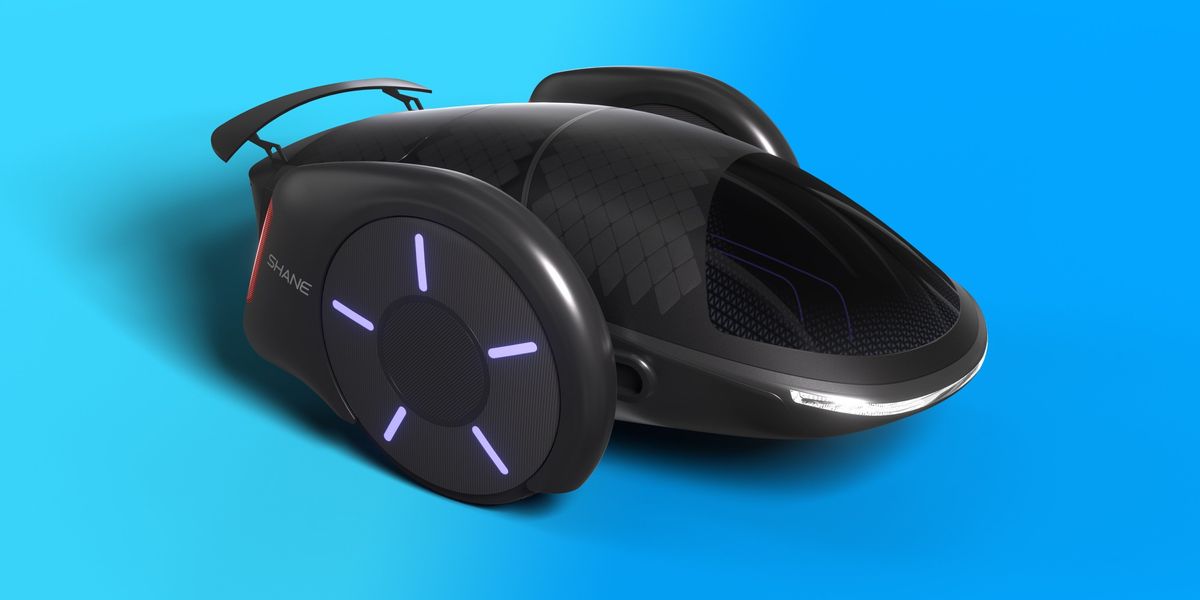When it comes to transportation, two wheels are better than one. That’s idea driving Shane, a two-wheeled vehicle that looks to reinvent one of the automotive industry’s most basic assumptions.
Its inventor, Shane Chen, has made a career out of gravity-defying ideas—first with the Hoverboard (which, Chen notes, was widely copied) but also with the SoloWheel, a self-balancing unicycle. His automotive concept, like his previous inventions, challenges long-held assumptions about personal transportation.
“I’d been thinking about the two-wheeled car for years, since I thought about a two-wheeled car people could use as a toy, for some kind of fun. It’s kind of in the back of my memory,” says Chen. “Then just recently, about two years ago, I suddenly thought, ah—I can solve that car problem now.”
A careful balance
The Shane concept, like the Hoverboard, cleverly manipulates weight to keep the vehicle stable. But the details are quite different.
“It’s actually the opposite concept. With the SoloWheel and the Hoverboard, it’s an inverted pendulum for auto-balance. You’re going to balance like a stick—the taller, the better,” says Chen. “With the car, it’s the opposite. The car has two large wheels. The center of the wheel is above the center of gravity of the car, so the car is already stable when sitting there, or when moving at a constant speed.”

It’s arguably a more intuitive idea than Chen’s past inventions. The Shane is stable because it’s balanced, and it’s balanced because the car’s oblong, podlike passenger compartment provides enough weight to keep the center of gravity directly beneath the wheels. Left alone, on a level stretch of pavement, the car can maintain its balance.
But a two-wheeler can’t just sit still and it can’t rely on smooth, level pavement. It needs to move, and the torque created by that movement, as well as the subtle effects of hills, dips, and the wind, will tip a two-wheeled vehicle one way or another. Move forward and the nose will try to tilt up; brake and the nose will push down.
Chen’s concept has an odd but elegant solution. The passenger pod becomes the counterbalance, moving forward and backward relative to the wheels. “It has instability when you brake or you accelerate. So my invention is to solve that problem. It’s already balanced when steady, right? But now, when you accelerate, the car doesn’t try to [tilt upwards],” says Chen.
Deceptively simple
A car with a constantly moving passenger pod might sound complex, but, on the contrary—simplicity is among the concept’s strengths. Ditching four wheels for two eliminates many potential problems.
Most cars use mechanical links and a multipart suspension system to steer, brake, and isolate imperfections in the road’s surface. Many modern cars have simplified this with fully electric steering, and some electric vehicles go a step further by moving the motors to each wheel. Still, the movements of each wheel must remain coordinated to steer, and the suspension must smooth bumps and potholes across four wheels.
“With a two-wheel car, you don’t have any of this,” says Chen. “You don’t even steer. You just control the speed [of each wheel], like the Hoverboard.” The Shane’s video trailer shows this with a display of parallel-parking prowess. Faced with a slim parking spot, the car rotates in place as the wheels move independently, like a tank.
Introducing SHANE: a first-of-its-kind parallel two-wheeled electric car concept Inventist, Inc
That would certainly help with the anxiety of finding a spot on a busy street—but you likely wouldn’t have to worry at all, as Chen’s concept would “do better with artificial intelligence and self-driving” than with a traditional steering wheel, he says. He again references the Hoverboard: “It’s so simple. There’s nothing there. Nothing to steer. It’s pure electronic control.”
A concept for an electric future
The simplicity of electronic control is what makes the Shane concept possible, but efficiency is the goal. Ditching four small wheels for two larger wheels improve the vehicle’s efficiency, which should help it achieve longer range on electric power.
This is partially thanks to friction, or the lack of it. With just two contact points, Chen sees the Shane more easily gliding across a road’s surface. The wheels also provide space to accommodate an electric hub motor that can provide direct power to each wheel, he says, much like the hyperefficient hub motors found in some modern electric cars, as well as regenerative shocks and brakes. Chen has even experimented with scale models that place the batteries in the wheels, though he suspects this wouldn’t prove practical in full-size vehicles.

This highlights the limits of what Chen can achieve alone. His prior concepts, like the Hoverboard and SoloWheel, were small enough to handle alone. A car, however, demands government-regulated testing of its aerodynamics, efficiency, safety equipment, and other elements of the design. Chen is looking for partners to help make the concept a reality and says he’s currently in talks with several companies.
It will be a challenge. Taking a new car from concept to production is difficult even when it has the usual number of wheels. But Chen, a lifelong inventor, seems ready for the long haul.
“I try to invent something that I know people need. It’s extremely hard—I may never get it in my whole life,” he says. “It’s kind of like a puzzle. You see things, you do things, and someday a certain puzzle piece fits.”
Matthew S. Smith is a freelance consumer technology journalist with 17 years of experience and the former Lead Reviews Editor at Digital Trends. An IEEE Spectrum Contributing Editor, he covers consumer tech with a focus on display innovations, artificial intelligence, and augmented reality. A vintage computing enthusiast, Matthew covers retro computers and computer games on his YouTube channel, Computer Gaming Yesterday.



